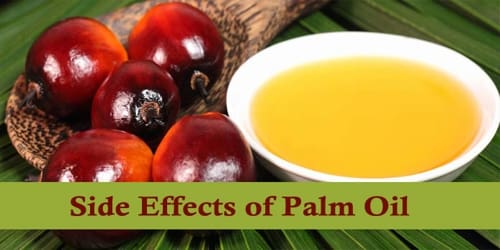Side Effects of Palm Oil
Introduction: Palm oil, an edible vegetable oil rich in saturated fats and free of trans fats, is derived from the mesocarp (reddish pulp) of the fruit of the oil palms, mainly the African oil palm (Elaeis guineensis) and to some extent from the South American oil palm (Elaeis oleifera) and the maripa palm (Attalea maripa).
Palm oil has become the second most traded oil crop in the world, after soy, with Malaysia and Indonesia as its main producers.
Palm oil is first and foremost edible oil. Experts suggest using unrefined red palm oil to ensure that people experience its nutritional benefits. However, it has a strong taste, which some people do not find to their liking. Applying palm oil directly to their skin is also beneficial. Injuries like bruises, sunburn, and cuts also heal faster when palm oil is applied.
Nutrient Composition of Palm Oil: Palm oil is 100% fat, half of which is saturated. It also contains vitamin E and red palm oil contains antioxidants called carotenoids, which our body can convert into vitamin A. It contains about 50 percent saturated fat (majority of which is oleic acid), 40 percent monounsaturated fatty acids (MUFAs), and 10 percent polyunsaturated fatty acid (PUFAs).
One cup of Palm oil serves 1909 calories and 216 g of total lipid fat. It also offers 0.02 mg of iron, 0.6 mg of choline, 34.43 mg of Vitamin E, 17.3 µg of Vitamin K, 106.488 g of total saturated fat, 0.216 g of lauric acid, 2.16 g of myristic acid, 93.96 g of palmitic acid, 9.288 g of stearic acid, 79.92 g of total monounsaturated fats, 0.648 g of palmitoleic acid, 79.056 g of oleic acid, 0.216 g of gadoleic acid, 20.088 g of total polyunsaturated fats, 19.656 g of linoleic acid and 0.432 g of Linolenic acid.
Red palm oil is rich in carotenes, such as alpha-carotene, beta-carotene, and lycopene, which give it a characteristic dark red color. However, palm oil that has been refined, bleached and deodorized from crude palm oil (called “RBD palm oil”) does not contain carotenes.

Side-Effects of Palm Oil: Consumption of red palm oil is safe, even in large amounts. It does not have any side effect similar to those induced by drugs. Because of palm oil’s composition, it metabolizes more effectively with food, so there is less risk of having abdominal discomfort or bowel problems.
Contributing significant calories as a source of fat, palm oil is a food staple in many cuisines. On average globally, humans consumed 17 pounds (7.7 kg) of palm oil per person in 2015. Although the relationship of palm oil consumption to disease risk has been previously assessed, the quality of the clinical research specifically assessing palm oil effects has been generally poor.
All palm oil is high in saturated fat, oxidized palm oil presents even greater health risks. The oxidization occurs during processing for culinary use, generating toxins that adversely affect the heart, liver, kidneys, and lungs. Raw, unprocessed palm oil isn’t associated with these effects when fresh; however, studies link a boost in atherosclerosis development in as little as six months when reheating palm oil to cook foods. Although the interaction is moderate, the oil is best avoided when health concerns include blood clots.
Palm Oil production is considered an environmental hazard as it is a major cause of global warming and changes in the overall climatic conditions. This happens while the land outside is cleared using fire and evacuating the habitats in the vicinity. The smoke of these agricultural fires is filled in the air for long weeks and sometimes months too.
One of the major reasons for orangutan extinction is being attributed to the production of Palm oil. Orangutans have lost out on their primary tropical rainforest which has resulted in cutting off their population from each other. This has left them in genetic and reproductive isolation.
Information Source:
















